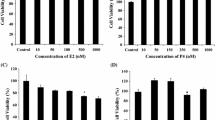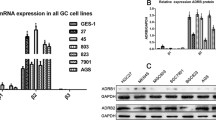Abstract
Psychosocial stress promotes cancer pathogenesis involving angiogenesis through alterations in neuroendocrine-immune functions that may involve adrenoceptor (AR)-dependent signaling mechanisms in the brain, lymphoid organs, and cancerous cells. Various concentrations of α1- and α2- AR-specific agonists and antagonists were incubated in vitro with estrogen receptor-positive (ER +) MCF-7, and ER (-) MDA MB-231 cells to examine the secretions of VEGF-A, VEGF-C, and nitric oxide (NO), and expression of signaling molecules- p-ERK, p-CREB, and p-Akt on the proliferation of breast cancer cell lines. Cellular proliferation, VEGF-A and NO secretion, expression of p-ERK, p-CREB, and p-Akt were enhanced in MCF-7 cells treated with α1-AR agonist while VEGF-C secretion alone was enhanced in MDA MB-231 cells. Treatment of MCF-7 and MDA MB-231 cells with α2- AR agonist similarly enhanced proliferation and decreased NO production and p-CREB expression while VEGF-C secretion was decreased in MCF-7 cells and p-Akt expression was decreased in MDA MB-231 cells. α1-AR inhibition reversed cellular proliferation and VEGF-A secretion by MCF-7 cells while α2-AR inhibition reversed the proliferation of MCF-7 and MDA MB-231 cells and VEGF-C secretion by MCF-7 cells. Taken together, breast cancer pathogenesis may be influenced by distinct α-AR-mediated signaling mechanisms on angiogenesis and lymphangiogenesis that are dependent on estrogen receptor status.












Similar content being viewed by others
References
Meites J. Relation of the neuroendocrine system to the development and growth of experimental mammary tumors. J Neural Transm. 1980;48:25–42.
ThyagaRajan S, Felten DL. Modulation of neuroendocrine–immune signaling by L-deprenyl and L-desmethyldeprenyl in aging and mammary cancer. Mech Ageing Dev. 2002;123:1065–79.
Danese A, McEwen BS. Adverse childhood experiences, allostasis, allostatic load, and age-related disease. Physiol Behav. 2012;106:29–39.
ThyagaRajan S, Madden KS, Teruya B, Stevens SY, Felten DL, Bellinger DL. Age-associated alterations in sympathetic noradrenergic innervation of primary and secondary lymphoid organs in female Fischer 344 rats. J Neuroimmunol. 2011;233:54–64.
ThyagaRajan S, Tran L, Molinaro CA, Gridley DS, Felten DL, Bellinger DL. Prevention of mammary tumor development through neuroimmunomodulation in the spleen and lymph nodes of old female sprague-dawley rats by L-deprenyl. NeuroImmunoModulation. 2013;20:141–51.
Roets E, Vandeputte-Van Messom G, Peeters G. Relationship between milkability and adrenoceptor concentrations in teat tissue in primiparous cows. J Dairy Sci. 1986;69:3120–30.
Hammon HM, Bruckmaier RM, Honegger UE, Blum JW. Distribution and density of alpha- and beta-adrenergic receptor binding sites in the bovine mammary gland. J Dairy Res. 1994;61:47–57.
Inderwies T, Pfaffl MW, Meyer HHD, Blum JW, Bruckmaier RM. Detection and quantification of mRNA expression of alpha- and beta-adrenergic receptor subtypes in the mammary gland of dairy cows. Domest Anim Endocrinol. 2003;24:123–35.
Vázquez SM, Pignataro O, Luthy IA. Alpha2-adrenergic effect on human breast cancer MCF-7 cells. Breast Cancer Res Treat. 1999;55:41–9.
Vázquez SM, Mladovan AG, Pérez C, Bruzzone A, Baldi A, Lüthy IA. Human breast cell lines exhibit functional alpha2-adrenoceptors. Cancer Chemother Pharmacol. 2006;58:50–61.
Bruzzone A, Piñero CP, Castillo LF, Sarappa MG, Rojas P, Lanari C, et al. Alpha2-adrenoceptor action on cell proliferation and mammary tumour growth in mice. Br J Pharmacol. 2008;155:494–504.
Obeid EI, Conzen SD. The role of adrenergic signaling in breast cancer biology. Cancer Biomark. 2013;13:161–9.
Priyanka HP, Singh RV, Pratap UP, ThyagaRajan S. Estrogen modulates β2-adrenoceptor-induced cell-mediated and inflammatory immune responses through ER-α involving distinct intracellular signaling pathways, antioxidant enzymes, and nitric oxide. Cell Immunol. 2014;292:1–8.
Chiesa IJ, Castillo LF, Lüthy IA. Contribution of alpha2-adrenoceptors to the mitogenic effect of catecholestrogen in human breast cancer MCF-7 cells. J Steroid Biochem Mol Biol. 2008;110:170–5.
Powe DG, Voss MJ, Habashy HO, Zänker KS, Green AR, Ellis IO, et al. Alpha- and beta-adrenergic receptor (AR) protein expression is associated with poor clinical outcome in breast cancer: an immunohistochemical study. Breast Cancer Res Treat. 2011;130:457–63.
Weil J, Benndorf R, Fredersdorf S, Griese DP, Eschenhagen T. Norepinephrine upregulates vascular endothelial growth factor in rat cardiac myocytes by a paracrine mechanism. Angiogenesis. 2003;6:303–9.
Maynadier M, Nirdé P, Ramirez J-M, Cathiard AM, Platet N, Chambon M, et al. Role of estrogens and their receptors in adhesion and invasiveness of breast cancer cells. Adv Exp Med Biol. 2008;617:485–91.
Razandi M, Pedram A, Levin ER. Plasma membrane estrogen receptors signal to antiapoptosis in breast cancer. Mol Endocrinol. 2000;14:1434–47.
P Priyanka H, S Nair R, 2020 Inspire Laboratory, Institute of Advanced Research in Health Sciences, Tamil Nadu Government Multi Super Speciality Hospital, Omandurar Government Estate, Chennai-600002. Neuroimmunomodulation by estrogen in health and disease. AIMS Neuroscience. 7: 401–17.
Armaiz-Pena GN, Cole SW, Lutgendorf SK, Sood AK. Neuroendocrine influences on cancer progression. Brain Behav Immun. 2013;30:S19-25.
Thaker PH, Han LY, Kamat AA, Arevalo JM, Takahashi R, Lu C, et al. Chronic stress promotes tumor growth and angiogenesis in a mouse model of ovarian carcinoma. Nat Med. 2006;12:939–44.
Priyanka HP, ThyagaRajan S. Selective modulation of lymphoproliferation and cytokine production via intracellular signaling targets by α1- and α2-adrenoceptors and estrogen in splenocytes. Int Immunopharmacol. 2013;17:774–84.
ThyagaRajan S, Hima L, Pratap UP, Priyanka HP, Vasantharekha R. Estrogen-induced neuroimmunomodulation as facilitator of and barrier to reproductive aging in brain and lymphoid organs. J Chem Neuroanat. 2019;95:6–12.
Young WF. Adrenal Medulla, Catecholamines, and Pheochromocytoma. Goldman’s Cecil Medicine [Internet]. Elsevier Inc.; 2011 [cited 2024 Jan 31]. p. 1470–5. Available from: http://www.scopus.com/inward/record.url?scp=84904370580&partnerID=8YFLogxK.
Dayanir V, Meyer RD, Lashkari K, Rahimi N. Identification of tyrosine residues in vascular endothelial growth factor receptor-2/FLK-1 involved in activation of phosphatidylinositol 3-kinase and cell proliferation. J Biol Chem. 2001;276:17686–92.
Dimmeler S, Fleming I, Fisslthaler B, Hermann C, Busse R, Zeiher AM. Activation of nitric oxide synthase in endothelial cells by Akt-dependent phosphorylation. Nature. 1999;399:601–5.
Fulton D, Gratton J-P, McCabe TJ, Fontana J, Fujio Y, Walsh K, et al. Regulation of endothelium-derived nitric oxide production by the protein kinase Akt. Nature. 1999;399:597–601.
Mayo LD, Kessler KM, Pincheira R, Warren RS, Donner DB. Vascular endothelial cell growth factor activates CRE-binding protein by signaling through the KDR receptor tyrosine kinase. J Biol Chem. 2001;276:25184–9.
X S, W W, Rd M, D B. Sphingosine kinase mediates vascular endothelial growth factor-induced activation of ras and mitogen-activated protein kinases. Molecular and cellular biology [Internet]. 2002 [cited 2024 Jan 18];22. Available from: https://pubmed.ncbi.nlm.nih.gov/12391145/.
Takahashi T, Ueno H, Shibuya M. VEGF activates protein kinase C-dependent, but Ras-independent Raf-MEK-MAP kinase pathway for DNA synthesis in primary endothelial cells. Oncogene. 1999;18:2221–30.
Fournier E, Blaikie P, Rosnet O, Margolis B, Birnbaum D, Borg JP. Role of tyrosine residues and protein interaction domains of SHC adaptor in VEGF receptor 3 signaling. Oncogene. 1999;18:507–14.
Koduri S, Goldhar AS, Vonderhaar BK. Activation of vascular endothelial growth factor (VEGF) by the ER-alpha variant, ERDelta3. Breast Cancer Res Treat. 2006;95:37–43.
Ciccarelli M, Santulli G, Campanile A, Galasso G, Cervèro P, Altobelli GG, et al. Endothelial α1-adrenoceptors regulate neo-angiogenesis. Br J Pharmacol. 2008;153:936–46.
Lüthy IA, Bruzzone A, Piñero CP, Castillo LF, Chiesa IJ, Vázquez SM, et al. Adrenoceptors: non conventional target for breast cancer? Curr Med Chem. 2009;16:1850–62.
Szpunar MJ, Burke KA, Dawes RP, Brown EB, Madden KS. The antidepressant desipramine and α2-adrenergic receptor activation promote breast tumor progression in association with altered collagen structure. Cancer Prev Res (Phila). 2013;6:1262–72.
Watanabe K, Zhang X-Y, Kitagawa K, Yunoki T, Hayashi A. The effect of clonidine on VEGF expression in human retinal pigment epithelial cells (ARPE-19). Graefes Arch Clin Exp Ophthalmol. 2009;247:207–13.
Pérez Piñero C, Bruzzone A, Sarappa MG, Castillo LF, Lüthy IA. Involvement of α2- and β2-adrenoceptors on breast cancer cell proliferation and tumour growth regulation. Br J Pharmacol. 2012;166:721–36.
Shen S-G, Zhang D, Hu H-T, Li J-H, Wang Z, Ma Q-Y. Effects of alpha-adrenoreceptor antagonists on apoptosis and proliferation of pancreatic cancer cells in vitro. World J Gastroenterol. 2008;14:2358–63.
Chen H, Liu D, Yang Z, Sun L, Deng Q, Yang S, et al. Adrenergic signaling promotes angiogenesis through endothelial cell-tumor cell crosstalk. Endocr Relat Cancer. 2014;21:783–95.
Zahalka AH, Arnal-Estapé A, Maryanovich M, Nakahara F, Cruz CD, Finley LWS, et al. Adrenergic nerves activate an angio-metabolic switch in prostate cancer. Science. 2017;358:321–6.
Funding
Supported by the Department of Bio-Technology (BT/PR9199/Med/30/12/2007), Government of India, New Delhi.
Author information
Authors and Affiliations
Contributions
Material preparation, data collection was performed by HPP and UPP. Data analysis was performed by HPP. The first manuscript draft was prepared by HPP and RV. The manuscript draft was edited, and revised critically by RSN, HPP, and RV. The figures were edited by RSN. Project supervision and acquisition of funds by STR and RV. All authors read and approved the final manuscript.
Corresponding author
Ethics declarations
Conflict of interest
The authors have no conflicts of interest to declare.
Ethical approval
This article does not contain any studies with human participants or animals performed by any of the authors.
Additional information
Publisher's Note
Springer Nature remains neutral with regard to jurisdictional claims in published maps and institutional affiliations.
Supplementary Information
Below is the link to the electronic supplementary material.
Rights and permissions
Springer Nature or its licensor (e.g. a society or other partner) holds exclusive rights to this article under a publishing agreement with the author(s) or other rightsholder(s); author self-archiving of the accepted manuscript version of this article is solely governed by the terms of such publishing agreement and applicable law.
About this article
Cite this article
Priyanka, H.P., Pratap, U.P., Nair, R.S. et al. Estrogen-receptor status determines differential regulation of α1- and α2-adrenoceptor-mediated cell survival, angiogenesis, and intracellular signaling responses in breast cancer cell lines. Med Oncol 41, 92 (2024). https://doi.org/10.1007/s12032-024-02322-8
Received:
Accepted:
Published:
DOI: https://doi.org/10.1007/s12032-024-02322-8




